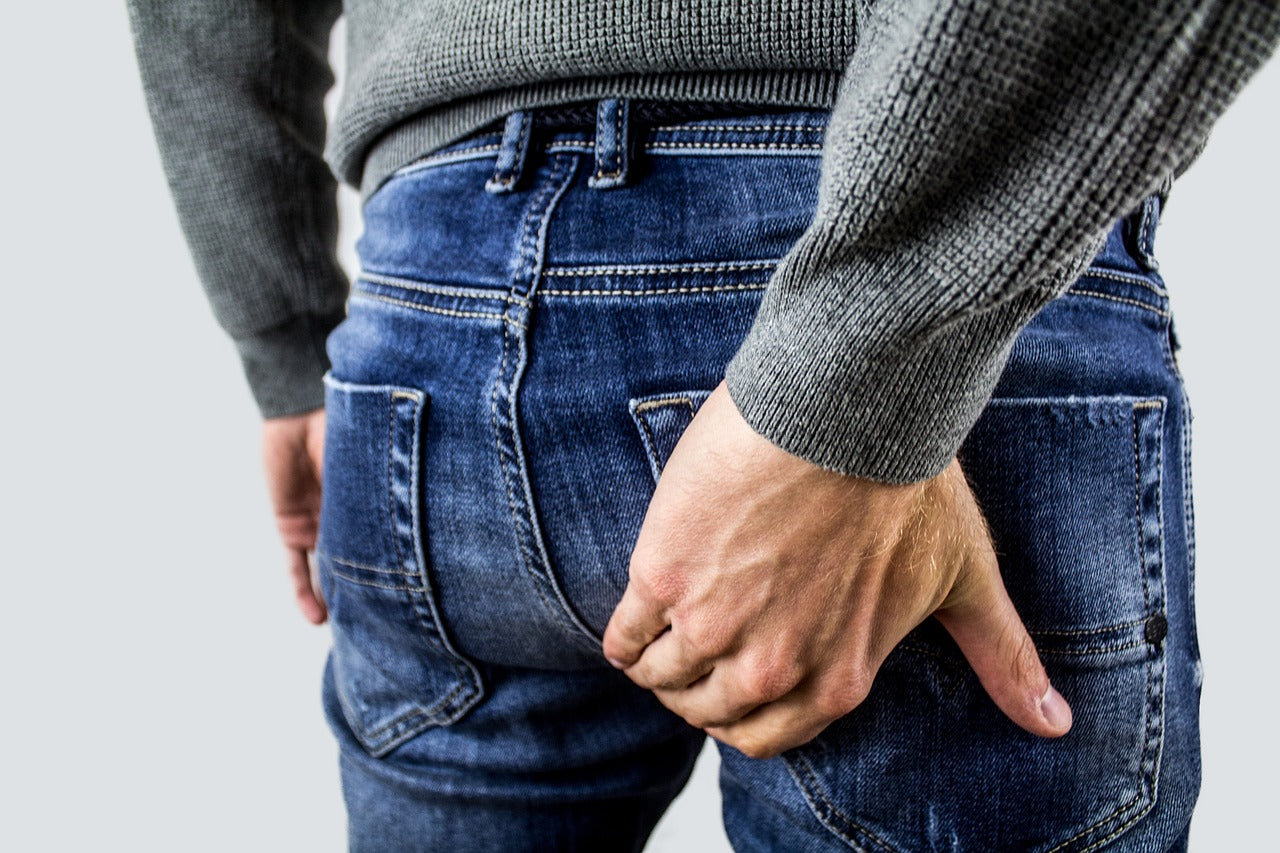
Hemorrhoids (Where they come from and how to treat them)
Hemorrhoids are uncomfortable.
They’re uncomfortable to suffer with, and they’re uncomfortable for many patients to talk about, much less seek medical treatment for.
No one likes to “assume the position” so their doctor can look at their posterior.
However, hemorrhoids are incredibly common and treatable. It’s estimated somewhere around 20 million adults suffer from them here in the States alone.
So that’s the good news.
In today’s article, I’ll discuss what causes these irritations and how you can naturally treat them.
Facts Around Hemorrhoids And What Causes Them
It’s not that uncommon for someone to develop hemorrhoids, primarily because we all have them.
You see, hemorrhoids consist of clusters of tissue full of blood vessels, right at the end of your rectum and just inside the anus. In fact, they play a pivotal role in regulating bowel movements along with the anal sphincter.
Now, when people complain about “having hemorrhoids,” they're referring to these clusters becoming swollen or enlarged.
This condition can lead to uncomfortable symptoms like itching, mucus discharge, or bleeding, primarily due to the thinning of blood vessel walls caused by hard stools.
Hemorrhoids can be internal or external, with the former being more prevalent.
External hemorrhoids may manifest as painful lumps near the anus, whereas swollen internal ones could protrude outside the anus, appearing as soft tissue lumps, also known as prolapsed hemorrhoids. This can create a sensation of pressure, making sitting a challenging task.
Another thing you may not know is hemorrhoids have different levels
They are rated from Grade 1 all the way to Grade 4.
Grade 1 is slightly enlarged but invisible from the outside, and Grade 4 is permanently external. It could be accompanied by rectal prolapse, where part of the rectal lining descends from the rectum.
One thing to note, though, is hemorrhoids are common, but other signs of blood in the stool are not and often indicate other health concerns that you should seek medical treatment for.
So, what causes them in the first place?
Here’s a brief list:
1 - Increased Pressure in the Lower Rectum: This can be caused by straining during bowel movements, sitting for long periods of time on the toilet, and conditions like constipation or diarrhea
2 -Aging: As you age, the tissues that support the veins in the rectum and anus can weaken and stretch. This weakening can increase the likelihood of hemorrhoids developing.
3 - Chronic Constipation or Diarrhea: Regular straining during bowel movements or sitting for an extended period of time can contribute to the formation of hemorrhoids.
4 Pregnancy: Many pregnant women who’ve never dealt with hemorrhoids before end up developing them as a result of the increased pressure on the lower abdomen during pregnancy. That pressure can cause the veins in the rectum and anus to swell. Additionally, hormonal changes during pregnancy can weaken the muscles supporting these veins. As well as the intense pressure caused by pushing a child out of the womb!
5 - Obesity: Being overweight can increase the pressure in the lower rectum, contributing to hemorrhoids. Yet another reason to manage your weight well.
6 - Genetics: This is likely one of the strongest factors of all, as a family history of hemorrhoids can certainly predispose you to develop them.
7 - Heavy Lifting: Regularly lifting heavy objects can strain the lower rectum, similar to the strain caused by constipation. This doesn’t mean you should stop lifting heavy; I’ll discuss that later.
Now, let's move on to ways to treat them!
Natural Ways to Help Improve Hemorrhoids
In some instances, hemorrhoids are so bad that you may need to resort to surgery or other more conventional methods.
But, most people can rectify their issues naturally.
1 - Change Your Diet
One of the chief causes of hemorrhoids has to do with eating foods that irritate your bottom.
So, here’s how you can effectively change your diet to find relief
Increase Fiber and Fat Intake
Ensuring you get enough fiber and fat will help you have bowel movements that are easier to manage and require less pushing.
Aim for a daily fiber intake of 30–35 grams, and try to get 50% of your calories or more from fat (sticking close to the ketogenic limits). Studies have shown that a high-fiber diet can significantly decrease the chances of hemorrhoid persistence and bleeding by about 50%.
Hydrate Regularly
Hydration can exacerbate constipation, as adequate hydration is essential for fiber to function effectively within the digestive system.
Research, including findings published in the European Journal of Clinical Nutrition, has highlighted that inadequate fluid intake can lead to constipation, aggravating hemorrhoid symptoms. To mitigate this, ensure you drink a glass of water with each meal and snack throughout the day.
Eat and Drink Fermented Foods
You know I love fermented foods, having just written on kimchi, and it happens that they are great for restoring gut flora and can also help with hemorrhoids. The truth is a healthy gut means efficient waste elimination, which means fewer instances of hemorrhoids.
Moderate Alcohol and Spicy Foods
Both alcohol and spicy foods can dehydrate and irritate the digestive system, potentially worsening hemorrhoid symptoms. Although the evidence is mixed, it's advisable to limit consumption of these items until hemorrhoid symptoms subside.
2 - Practice Better Toilet Behavior
I wasn’t sure how to write the recommendation above, so here’s what you need to know
You Should Minimize Straining.
Don’t try to force a bowel movement; instead, let your bathroom habits respond promptly to the body's cues for bowel movements (when you feel the need, then you need to go then and not wait) to avoid stool hardening, which leads to increased straining. Take your time in the bathroom, allowing your body to relax.
But don’t sit in there forever. Sitting on the toilet for too long can intensify hemorrhoid issues. Avoid distractions that might prolong toilet time (e.g., don’t bring your phone in).
Also, when it comes to straining, if you lift weights, try to brace your core more when lifting heavy weights. This will balance the load as you use your abdominal muscles to lift.
3 - Take Supplements
There are a few supplements that may help with hemorrhoids, too. These include:
Butcher’s Broom: This herb has been shown to alleviate swelling and inflammation and benefit hemorrhoid sufferers and those with chronic venous insufficiency.
Pycnogenol®: Orally and topically applied Pycnogenol® has been demonstrated to treat acute hemorrhoidal episodes, reducing symptoms significantly and effectively.
Horse Chestnut: Known for improving blood flow and reducing swelling, horse chestnut is beneficial for hemorrhoid relief.
Witch Hazel: Applying witch hazel topically can decrease inflammation and soothe hemorrhoid pain due to its astringent properties.
Psyllium Husk: A natural fiber source, psyllium husk can ease bowel movements and prevent the straining that exacerbates hemorrhoids. Ensure adequate water intake when using psyllium husk.
MSM: MSM supplements, especially when combined with tea tree oil, can reduce the pain and swelling associated with hemorrhoids.
4 - Topical Application Essential Of Oils
Essential oils can be wonderful for hemorrhoids, too.
Try these two out for relief.
Cypress Oil: With its ability to stop bleeding and promote clotting through astringent properties, cypress oil can be applied topically to affected areas.
Helichrysum Oil: Helichrysum oil aids digestion and is anti-inflammatory when used topically, potentially relieving hemorrhoid symptoms.
What If These Treatments Don’t Work?
You may wonder what to do if these treatments or suggestions don’t work. As I mentioned, there are conventional treatments that you could try.
They include:
Sclerotherapy: This involves injecting a chemical into a vein to block it, turning the vessel into scar tissue.
Rubber Band Ligation: This is where a rubber band is placed around a hemorrhoid to cut off its blood supply, causing it to wither. It's effective for treating hemorrhoids, though fourth-grade cases may see higher recurrence.
Infrared Coagulation: This uses infrared light to scar and cut blood supply to hemorrhoids, with less postoperative pain than band ligation but a higher failure rate.
Hemorrhoid Surgery: Less common now, surgery involves removing the hemorrhoid. It's considered when other treatments fail, with two to three weeks of recovery.
Hopefully, you don’t need to go these routes, but they are available should you need to use them.
And now, a somewhat uncomfortable subject is done and behind us 🤣!



